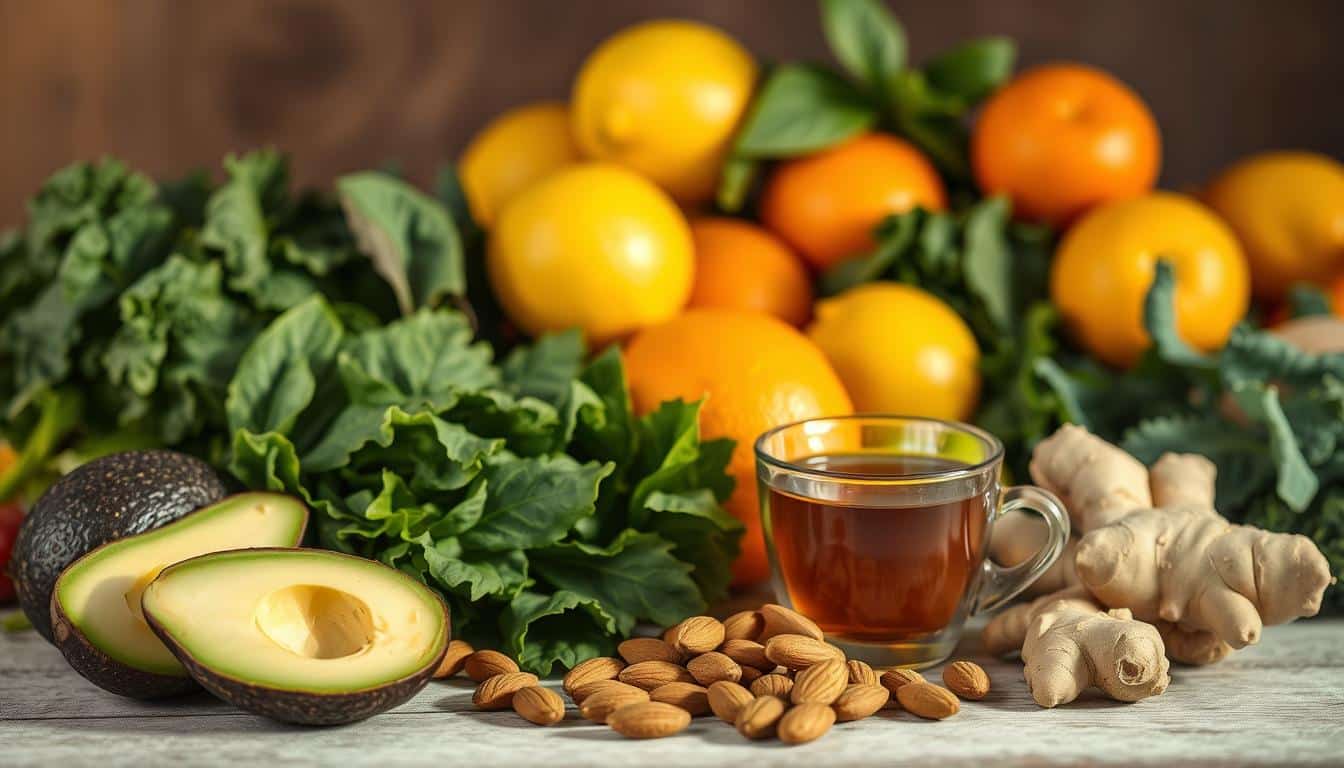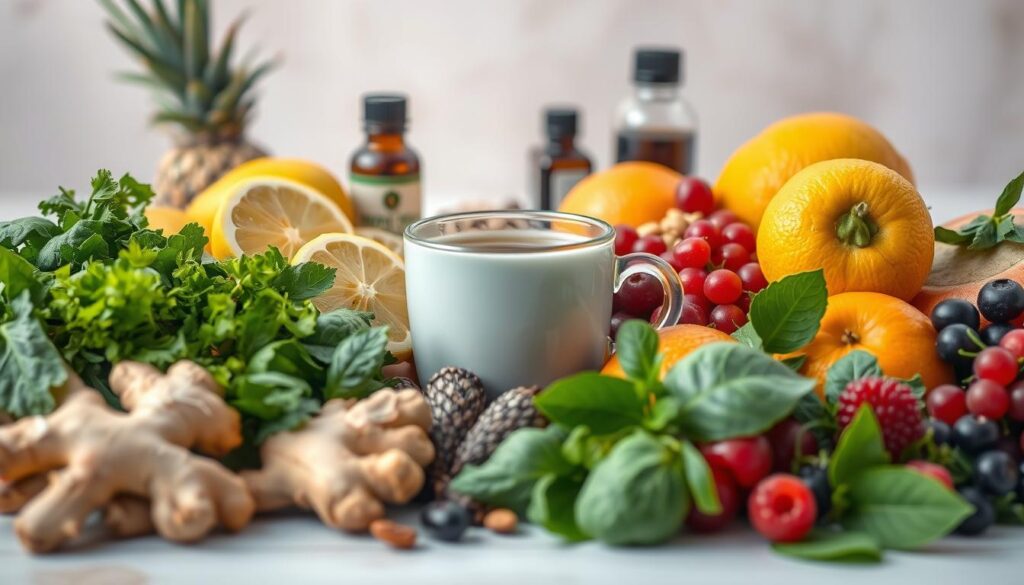Headaches can be debilitating, affecting daily life and productivity. While there are various treatments available, incorporating natural remedies into your diet can be a simple and effective way to find headache relief. Dietary changes play a significant role in managing headaches, and certain foods can help alleviate symptoms.
Making informed choices about what you eat can have a significant impact on your overall well-being. By exploring the connection between diet and headaches, you can take the first step towards a healthier, headache-free life. Dietary changes can be a powerful tool in achieving this goal.
Anúncios
Key Takeaways
- Certain foods can help alleviate headache symptoms.
- Dietary changes can play a significant role in managing headaches.
- Incorporating natural remedies into your diet can be a simple and effective way to find relief.
- Making informed choices about your diet can improve overall well-being.
- A healthier diet can lead to a headache-free life.

Natural Foods to Relieve Headaches
Understanding Different Types of Headaches
Understanding the different types of headaches is crucial for effective relief. Headaches can be broadly classified into several types, each with its unique symptoms, causes, and triggers.
Tension Headaches: Symptoms and Causes
Tension headaches are the most common type, characterized by a dull, aching pain on both sides of the head. They are often caused by muscle tension in the neck and scalp, usually triggered by stress, poor posture, or fatigue.
Anúncios
Migraines: Triggers and Warning Signs
Migraines are severe, throbbing headaches, typically on one side of the head, accompanied by nausea, vomiting, and sensitivity to light and sound. Triggers include hormonal changes, certain foods, and stress. Warning signs often precede the headache, such as aura or tingling sensations.
Cluster Headaches and Their Patterns
Cluster headaches are extremely painful, occurring in clusters or cycles, often at the same time each year. They are characterized by severe, one-sided pain, typically around the eye, and can be accompanied by tearing, redness, and swelling.
Sinus Headaches vs. Sinus Infections
Sinus headaches are often confused with sinus infections. While both can cause facial pain and pressure, sinus headaches are usually due to inflammation or infection of the sinuses, whereas sinus infections involve bacterial or viral infections.
| Headache Type | Symptoms | Causes/Triggers |
|---|---|---|
| Tension Headache | Dull, aching pain on both sides | Stress, poor posture, fatigue |
| Migraine | Throbbing pain, nausea, sensitivity to light/sound | Hormonal changes, certain foods, stress |
| Cluster Headache | Severe, one-sided pain around the eye | Cyclical patterns, often at the same time yearly |
| Sinus Headache | Facial pain, pressure | Sinus inflammation or infection |
The Connection Between Diet and Headaches
Exploring the connection between diet and headaches reveals potential pathways to relief. The food we consume plays a crucial role in our overall health, and its impact on headaches is significant.
How Food Affects Brain Chemistry and Pain Perception
Certain foods can influence brain chemistry, affecting pain perception. For instance, foods rich in magnesium and riboflavin have been shown to have a positive impact on headache frequency and severity.
Common Food Triggers to Avoid
Identifying and avoiding common food triggers is a crucial step in headache management. Some of the most common culprits include:
- Processed foods
- Foods containing MSG or artificial sweeteners
- Caffeine and alcohol
The Critical Role of Hydration in Headache Prevention
Staying hydrated is essential for headache prevention. Dehydration can lead to headache episodes, making it crucial to drink plenty of water throughout the day.
Blood Sugar Fluctuations and Headaches
Fluctuations in blood sugar levels can also trigger headaches. Maintaining stable blood sugar levels through a balanced diet is vital.
| Dietary Factor | Impact on Headaches |
|---|---|
| Hydration | Dehydration can trigger headaches |
| Blood Sugar Levels | Fluctuations can lead to headache episodes |
| Food Triggers | Avoiding triggers can reduce headache frequency |
By understanding the connection between diet and headaches, individuals can make informed dietary changes to alleviate and prevent headache episodes.
Natural Foods That Relieve Headaches

Certain natural foods have been found to possess properties that can alleviate headache symptoms. Incorporating these foods into your diet can be a proactive step towards managing headache frequency and severity.
Magnesium-Rich Foods: Spinach, Almonds, and Black Beans
Magnesium deficiency is often linked to headaches. Consuming magnesium-rich foods like spinach, almonds, and black beans can help alleviate this deficiency. Spinach is versatile and can be added to salads, smoothies, or sautéed as a side dish. Almonds make for a healthy snack, while black beans are a great addition to soups and stews.
Foods High in Riboflavin: Eggs, Mushrooms, and Dairy
Riboflavin, or Vitamin B2, plays a crucial role in energy production and can help reduce the frequency of migraines. Foods rich in riboflavin include eggs, mushrooms, and dairy products. Incorporating these into your meals can be as simple as having an omelette for breakfast, adding mushrooms to your pasta, or enjoying a glass of milk.
Omega-3 Fatty Acid Sources: Salmon, Walnuts, and Flaxseeds
Omega-3 fatty acids are known for their anti-inflammatory properties, which can help in reducing headache severity. Salmon, walnuts, and flaxseeds are excellent sources of omega-3s. Grilled salmon makes for a healthy dinner, while walnuts can be snacked on throughout the day. Flaxseeds can be added to oatmeal or yogurt.
Potassium-Packed Options: Bananas, Avocados, and Sweet Potatoes
Potassium is essential for maintaining healthy blood vessel function, and its deficiency can lead to headaches. Bananas, avocados, and sweet potatoes are rich in potassium. Enjoy bananas as a quick snack, add sliced avocados to your salad, or bake sweet potatoes as a side dish.
By incorporating these nutrient-rich foods into your diet, you can take a significant step towards managing headaches naturally. A balanced diet, combined with adequate hydration, can significantly reduce headache frequency and severity.
Hydrating Foods to Prevent Headaches
Proper hydration is key to preventing headaches, and incorporating hydrating foods into your diet can make a significant difference. Dehydration is a common trigger for headaches, and maintaining the body’s fluid balance is crucial for overall health.
Cucumber, Watermelon, and Celery Benefits
Foods with high water content are excellent for hydration. Cucumbers, watermelon, and celery are not only refreshing but also rich in water, making them perfect for maintaining fluid balance. Cucumbers are composed of about 96% water, while watermelon is approximately 92% water. Celery, with its high water content and electrolytes, helps in replenishing lost salts.
Citrus Fruits: Oranges, Grapefruits, and Lemons
Citrus fruits like oranges, grapefruits, and lemons are not only hydrating but also rich in vitamin C, which has anti-inflammatory properties. Oranges are about 87% water, making them a juicy and refreshing choice. Grapefruits and lemons, while less water-dense, contribute to overall hydration and provide a boost of antioxidants.
Coconut Water: Nature’s Electrolyte Solution
Coconut water is a natural source of electrolytes, including potassium, sodium, and magnesium. These electrolytes are crucial for maintaining the body’s hydration status and can be particularly beneficial after exercise or during hot weather. Coconut water is a more natural alternative to sports drinks and can help in replenishing lost electrolytes.
Broths and Clear Soups for Hydration
Clear broths and soups are another effective way to stay hydrated. They not only provide fluids but can also offer essential salts and minerals. Chicken broth or vegetable broth can be soothing and hydrating, especially when you’re not feeling well. These broths can be a gentle way to replenish fluids and electrolytes.
By incorporating these hydrating foods into your diet, you can help maintain your body’s fluid balance and potentially reduce the frequency of headaches. Remember, staying hydrated is a simple yet effective step towards better health.
Anti-Inflammatory Foods for Headache Relief
Anti-inflammatory foods offer a natural approach to alleviating headache symptoms. By incorporating these foods into your diet, you can potentially reduce the frequency and severity of headaches.
Ginger: Preparation Methods and Dosage
Ginger has been used for centuries for its anti-inflammatory properties. It contains compounds like gingerol, which can help reduce pain and inflammation. To incorporate ginger into your diet, you can make ginger tea by steeping fresh ginger in hot water or add it to your meals as a spice.
Preparation Methods: Ginger can be consumed fresh, dried, or as a supplement. It’s also available in tea form or as an ingredient in various recipes.
Turmeric and Curcumin: Adding Black Pepper for Absorption
Turmeric contains curcumin, a powerful anti-inflammatory compound. Curcumin has been shown to reduce inflammation and alleviate pain. To enhance the absorption of curcumin, it’s recommended to consume it with black pepper, which contains piperine.
Tip: Add a pinch of black pepper to your turmeric tea or dishes to boost curcumin absorption.
Leafy Greens: Kale, Spinach, and Swiss Chard
Leafy greens are rich in antioxidants and other nutrients that can help reduce inflammation. Incorporating these greens into your diet can be as simple as adding them to salads, smoothies, or sautéing them as a side dish.
- Kale is rich in vitamins A, C, and K, and minerals like calcium.
- Spinach is packed with iron and antioxidants.
- Swiss chard is a good source of magnesium and fiber.
Berries and Their Antioxidant Properties
Berries are known for their high antioxidant content, which can help combat inflammation. Enjoy berries as a snack, add them to your oatmeal, or blend them into a smoothie.
Antioxidant Benefits: Berries contain anthocyanins, which have been shown to reduce inflammation and improve cardiovascular health.
Fatty Fish and Olive Oil Benefits
Fatty fish like salmon and sardines are rich in omega-3 fatty acids, which have potent anti-inflammatory effects. Olive oil is another anti-inflammatory staple, rich in oleocanthal, which has been shown to reduce inflammation.
| Food | Anti-Inflammatory Benefits |
|---|---|
| Salmon | Rich in omega-3 fatty acids |
| Olive Oil | Contains oleocanthal, which reduces inflammation |
| Sardines | High in omega-3s and antioxidants |
By incorporating these anti-inflammatory foods into your diet, you can take a proactive approach to managing headaches and improving your overall health.
Caffeine-Containing Foods: Friend or Foe?

Understanding caffeine’s impact on headaches requires a nuanced approach, considering both its positive and negative effects. Caffeine is a widely consumed stimulant found in various foods and beverages, and its role in headache management is complex.
The Dual Nature of Caffeine in Headache Treatment
Caffeine can both trigger and relieve headaches, depending on the individual and their consumption patterns. Its ability to constrict blood vessels and block pain pathways can provide relief, but excessive intake can lead to withdrawal headaches.
Coffee and Tea: Optimal Consumption Patterns
When it comes to coffee and tea, moderation is key. Consuming 1-2 cups per day can be beneficial for some headache sufferers, while excessive consumption can exacerbate the problem. It’s essential to monitor your body’s response to these beverages.
Dark Chocolate: Beneficial Compounds Beyond Caffeine
Dark chocolate contains compounds like flavonoids, which may help alleviate headache symptoms. While it does contain some caffeine, the amounts are typically small compared to coffee or tea. Enjoying a small amount of dark chocolate daily might be beneficial, but be mindful of overall caffeine intake.
Finding Your Personal Caffeine Threshold
To harness the benefits of caffeine while minimizing risks, it’s crucial to determine your personal threshold. Keep a headache diary to track your caffeine intake and headache occurrences. This will help you identify the optimal amount of caffeine for your body.
In conclusion, managing caffeine intake is a delicate balance between leveraging its benefits and avoiding its pitfalls. By being mindful of your consumption and monitoring your body’s response, you can make informed decisions to help alleviate headache symptoms.
Creating a Headache-Prevention Meal Plan
To prevent headaches, it’s essential to create a balanced diet that includes headache-fighting foods. A well-structured meal plan can help maintain stable blood sugar levels and ensure adequate intake of crucial nutrients like magnesium and B vitamins.
Balanced Breakfast Options to Start Your Day
Begin your day with a nutritious breakfast that includes foods rich in magnesium and B vitamins. Examples include oatmeal with almonds and banana slices, or scrambled eggs with spinach and whole-grain toast.
Headache-Fighting Lunch Ideas
For lunch, incorporate foods high in omega-3 fatty acids and antioxidants. Grilled salmon with quinoa and steamed vegetables, or a salad with mixed greens, walnuts, and avocado, are excellent choices.
Dinner Recipes Rich in Magnesium and B Vitamins
Dinner can include magnesium-rich foods like black beans, spinach, and dark chocolate. Try a black bean and sweet potato enchilada dish, or a spinach and feta stuffed chicken breast.
Strategic Snacking to Maintain Blood Sugar Levels
Snacking between meals can help prevent blood sugar dips that may trigger headaches. Opt for snacks like almonds, cashews, or apple slices with peanut butter.
Sample 7-Day Meal Plan
Here’s a sample meal plan to help you get started:
| Day | Breakfast | Lunch | Dinner | Snacks |
|---|---|---|---|---|
| Monday | Oatmeal with banana and almonds | Grilled chicken salad | Black bean enchiladas | Apple slices with peanut butter |
| Tuesday | Scrambled eggs with spinach | Salmon with quinoa | Sweet potato and black bean tacos | Almonds and dark chocolate |
| Wednesday | Avocado toast with eggs | Turkey and avocado wrap | Grilled chicken with roasted vegetables | Cottage cheese with fruit |
| Thursday | Smoothie bowl with spinach and banana | Grilled salmon salad | Lentil soup with whole-grain bread | Carrot sticks with hummus |
| Friday | Omelette with mushrooms and whole-grain toast | Chicken Caesar salad | Grilled shrimp with quinoa and steamed broccoli | Rice cakes with almond butter |
| Saturday | Pancakes with fresh berries and maple syrup | Turkey and cheese sandwich on whole-grain bread | Beef and vegetable stir-fry | Greek yogurt with honey |
| Sunday | Breakfast burrito with scrambled eggs and black beans | Chicken quesadilla | Baked chicken with roasted sweet potatoes and green beans | Trail mix with nuts and dried fruit |
Natural Beverages for Headache Relief
For those seeking headache relief, exploring natural beverage options is a promising approach. Certain drinks have been found to alleviate headache symptoms, providing a natural alternative to medication.
Herbal Teas: Feverfew, Butterbur, and Peppermint
Herbal teas are a soothing way to find headache relief. Feverfew and butterbur are known for their anti-inflammatory properties, while peppermint tea can help relax tense muscles. These teas can be easily incorporated into your daily routine.
To prepare, steep a teaspoon of dried feverfew or butterbur leaves in boiling water for 5-10 minutes. Peppermint tea can be made by steeping fresh leaves for 3-5 minutes.
Anti-Inflammatory Smoothie Recipes
Smoothies can be a delicious way to combat headaches. Ingredients like berries, rich in antioxidants, and ginger, with its anti-inflammatory properties, can be combined to create a headache-fighting drink.
- Combine frozen berries, a banana, and a ginger slice in a blender.
- Add almond milk or yogurt for a creamy texture.
- Blend until smooth and enjoy as a snack or post-workout drink.
Infused Waters with Headache-Fighting Ingredients
Infused water is another refreshing option. Adding slices of lemon, lime, or ginger can enhance flavor and provide health benefits. These ingredients have anti-inflammatory properties that may help alleviate headache symptoms.
What to Drink When a Headache Strikes
When a headache occurs, staying hydrated is crucial. Coconut water is an excellent choice due to its electrolyte content, helping to replenish fluids. Herbal teas like peppermint or ginger tea can also provide quick relief.
Scientific Evidence Behind Food-Based Headache Remedies
Emerging evidence supports the use of food-based remedies in headache management. The scientific community has been actively exploring the link between diet and headaches, providing valuable insights into how specific foods and nutrients can alleviate or exacerbate headache symptoms.
Clinical Studies on Dietary Interventions
Numerous clinical studies have investigated the impact of dietary interventions on headache frequency and severity. For instance, research has shown that magnesium supplementation can reduce migraine frequency. A study published in the Neurology journal found that magnesium oxide supplementation significantly reduced migraine frequency in patients with menstrual migraines.
The Role of Antioxidants and Flavonoids
Antioxidants and flavonoids, found abundantly in fruits, vegetables, and other plant-based foods, play a crucial role in reducing oxidative stress and inflammation, which are associated with headache development. Foods rich in antioxidants, such as berries and leafy greens, have been shown to have a positive impact on headache symptoms.
Nutritional Deficiencies Linked to Headaches
Nutritional deficiencies, particularly in magnesium, riboflavin (B2), and omega-3 fatty acids, have been linked to an increased risk of headaches. Ensuring adequate intake of these nutrients through diet or supplementation can help mitigate headache symptoms.
Integrating Evidence-Based Approaches
By integrating evidence-based dietary approaches, individuals can develop a personalized plan to manage headaches. This involves incorporating foods rich in antioxidants, flavonoids, and other beneficial compounds, while avoiding trigger foods and maintaining optimal hydration.
Conclusion
Understanding the connection between diet and headaches is crucial for effective headache management. By incorporating natural foods rich in magnesium, riboflavin, omega-3 fatty acids, and potassium, individuals can find significant headache relief. Foods such as spinach, almonds, eggs, salmon, and bananas are not only nutritious but also help in preventing headaches.
Dietary changes play a vital role in reducing the frequency and severity of headaches. Staying hydrated with hydrating foods like cucumber, watermelon, and coconut water, and consuming anti-inflammatory foods such as ginger, turmeric, and berries can provide natural remedies for headache sufferers.
By making informed dietary changes and incorporating the suggested natural foods and beverages into daily routines, individuals can take a proactive approach to managing headaches. A well-planned diet can lead to a significant reduction in headache occurrences, improving overall quality of life.
FAQ
What are some common food triggers for headaches?
How does hydration impact headache prevention?
Can certain nutrients help alleviate headache symptoms?
How can I incorporate anti-inflammatory foods into my diet to help with headache relief?
What is the role of caffeine in headache management?
Are there any specific beverages that can help with headache relief?
Can a meal plan help prevent headaches?
Is there scientific evidence supporting the use of dietary interventions for headache management?
Content created with the help of Artificial Intelligence.



